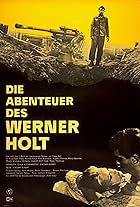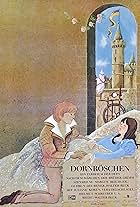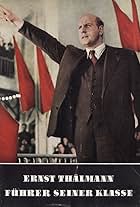Advanced search
- TITLES
- NAMES
- COLLABORATIONS
Search filters
Enter full date
to
or just enter yyyy, or yyyy-mm below
to
to
to
Exclude
Only includes titles with the selected topics
to
In minutes
to
1-50 of 161
- Whites expel Dakotas from Black Hills after finding gold, defying treaty. Chief's son Tokei-ihto rejects barren reservation after his father's murder. Out of prison, he leads tribe's flight to Canada, confronting murderer Red Fox.
- A German stage actor's cult following and popularity after protesting the 1968 invasion of Czechoslovakia
- Eight space cargo-ships disappear without a trace within three days. And the orbit station "Margot" has suddenly fallen silent. The space council is faced with a mystery and the scientist in charge, Maria Scholl, sees no other solution than ordering a total flight stop to this mysterious sector of space. Her colleague, Prof. Tal seems to be suspicious since he knows things before they are even released. A forbidden look into his personal file brings to light that Tal was part of the Eolomea project that never found approval of the commission in charge.
- Two people love each other when they know they should not. Their parents' and friends' pleas, their social backgrounds and reputation, their careers; everything is used to make them give each other up. Flattery, lies and threats finally drive Frank to despair and Karin to treason. But it is not due to their parents' hatred, nor to any greed for inherited wealth. Rather, the mere conjecture expressed by the authorities is enough to set off a merciless mechanism...
- In the little town of Herzsprung - whose name harks back to an ancient legend of broken hearts - almost nothing has changed since German unification, except a rise in unemployment. Johanna, a young mother and widow, becomes one of the unemployed and lives on welfare. To make matters worse, she falls in love with a dark-skinned, roving adventurer and the whole village starts talking about it. Director Helke Misselwitz became internationally known for her documentary Winter Adé (1988), about women in the final years of the GDR. Herzsprung was her feature film debut. The lyrics for the song, "Oh, Your First Love," sung by Eva-Maria Hagen, were adapted by singer-songwriter Wolf Biermann, expelled from the GDR in 1976.
- Once upon a time, there lived a lazy miller who spent all his time drinking wine and telling stories. When the king's treasurer comes to him with a demand to pay the tax, the miller lies that his daughter Marie can spin gold from straw.
- Nine-year old George, son of British settlers, is kidnapped by Iroquois and raised by the chief who adopts him. Later he gets the chance to return to his family but refuses because he has discovered that the palefaces are the true savages.
- Little Sabine has spent her childhood in an orphanage after her parents died in a car accident. When one of the women in charge at the orphanage, Edith, leaves to have a baby, Sabine runs away, because Edith was the only adult there she could trust. She then wanders through the city to find someone to take her in. She meets a lot of people on her journey, but she seems out of place everywhere she goes until, at last, she realizes that there is a special place where she belongs.
- After landing on TEM 4 following a distress call, the crew finds Temers denying sending it. At a ruler's party, drugged food clouds their minds. Navigator Suko, alone on the ship, makes a horrific discovery.
- In one fairy-tale kingdom, the princess stopped laughing. No one knows the cause of this sudden illness. The worried king promises half the kingdom and a daughter in marriage to the one who will make the princess at least smile.
- Democritus suffers a toothache. A dentist heads to treat him but fights with a donkey driver, sparking chaos in Abdera. As the city nears civil war, Democritus' apprentice arrives with a gift that eases tensions.
- During Great Depression, a family is evicted from their apartment and with no other option they move to a tent camp called Kuhle Wampe.
- Ten-year-old Ernst wants to go on a bike ride with his father Alfons, but his mother decides that they should all go to Seifertsgrün together for their golden wedding anniversary. Finally, she is persuaded to let the two of them ride their bikes if they promise to arrive on time. Ernst and Alfons set off - from Mecklenburg to the Erzgebirge. It is a journey with many obstacles and adventurous experiences, because Alfons intervenes wherever help is needed. Among other things, he saves a skydiver's bride who has landed in a tree in her wedding dress. The agreed time draws ever closer, and father and son are still a long way from Seifertsgrün. But they too get help and land at the banquet table in an airplane.
- Once upon a time there was a little girl named Rotkaeppchen. She lived with her father and mother at the edge of a village, and often visited her grandmother on the other side of the woods. Her rabbit friend, Haeschen, lives with Grandmother and was sent one day to fetch medicine and milk from Rotaeppchen and her mother. Although her mother was reluctant to allow her to visit Grandmother alone, Rotkaeppchen convinces her that she will be safe with Haeschen. Together they set out through the woods. Unfortunately, there were many distractions in the woods: mushrooms to pick and Rotkaeppchen's other playmate, the bear. There are also the dangerous fox and wolf, who plotted to capture Rotkaeppchen and eat her. Haeschen did his best to keep them safe, but he could not prevent the wolf from eating Grandmother . . . and also Rotkaeppchen! Who will save them? The DEFA version of Rotkaeppchen differs from the Grimms' version in some minor areas: the mother plays a greater role in the film; DEFA has the father save the day, rather than the huntsman; the wolf does not die at the end, though he is carried away by the family; the second encounter with the wolf at the end of the original tale is left out; and a few animal characters are added (Haeschen, Baer, and das Eichhoernchen). All the animals (other than the Eichhoernchen) are played by people in animal costumes, and Jochen Bley as Haeschen was the big hit with critics and viewers alike. Both warmly and critically received by the press upon its release, Rotkaeppchen followed closely on the heels of the very successful Schneewittchen; hence, in some cases, the disappointment. Many reviews cited Goetz Friedrich's background in theater (both in positive and negative interpretations) to explain the spare, two-dimensional feel of the set. Yet nearly all commented positively on the color and interesting characters, and the Progress press materials summed up the morals for the viewers to learn: "Do what you are told, but act independently when it is necessary; never leave the path, especially the path that your friends have marked with love and experience; be brave, fight against evil, help your friends." Since its release, Rotkaeppchen has become one of the most popular DEFA fairy tale films.
- Two teenagers are drafted into Hitler's army. One becomes fanatical, while the other realizes war's senselessness. When his friend is executed, the disillusioned soldier turns against his own forces in this anti-war film based on a novel.
- Winter 1968. Historian Dr. Dallow is released from prison. He is still trying to cope with and understand why he was put behind bars for 21 months for defamation of the state. His supposed "crime:" for five minutes, he accompanied a cabaret chanson on the piano. The film shows what "ordinary socialism" was like, letting the audience feel the threat under which the people in the GDR had to live over many years.
- When the Fairy of Industry is not invited to the birth of the princess, she sees that the child pricks her finger on a spindle and falls in a cursed sleep. For 100 years she has to wait for a prince to awaken her again.
- Based on the 1947 book "I.G. Farben", by American author Richard Sasuly, and records from the Nuremberg Trial of the chemical giant I.G. Farben, Council of the Gods is a story about the collaboration between international corporations and German scientists, whose research contributed to the death of millions. Featuring music by Hanns Eisler, electronic sound by Oskar Sala (Hitchcocks's "The Birds") and a script by Friedrich Wolf, the film is powerful in its depiction of the moral dilemmas and lessons of the war, as well as of Cold War propaganda. Chemist Dr. Hans Scholz lives through a tortuous political transformation and maturation process. Finally, he becomes wrapped up in his political neutrality and closes his eyes to the fact that poison is being produced in his factory. Standing before the judges at the Nuremberg trials he has to face the fact that he was partly responsible for the deaths of millions in the gas chambers of the extermination camps.
- After a hot and steamy company party, Sibylle and Harald, both in their late thirties, spend the night together. They meet each other later and resolve to enter into a strictly intellectual relationship. He is a widower with two sons, with the younger son just entering school. She is single and relatively satisfied in her relationship with a married colleague. Suddenly, Sibylle quits her job at the company's staff canteen and delves into her new self-appointed task with fiery fervor: to pep up Harald's family life, turning his house, garden, etc. inside out. Harald, a quiet man used to peace and his own habits, starts to flee from her on a daily basis. Without love, she figures, the relationship will not work out. But it does not take long for the pair to miss each other's presence.
- Once upon a time there was a widow who had two daughters: one was her own, the other was a stepdaughter. The eldest relative was ugly and lazy, and the youngest was beautiful and hardworking.
- The second part of the Ernst Thälmann films encompasses the time period between 1930 and Thälmann's murder in 1944. It shows Thälmann's battle to achieve a united front with all German workers against the National Socialists, his arrest following Hitler's seizure of power and the eleven years of his incarceration, in which he is unwavering in his beliefs until his death. An attempt to free him on the part of his comrades ends disastrously, and a corrupt offer of freedom from Göring himself receives Thälmann's refusal. He must also witness how his brave fellow Socialist Aenne Jansen in the women's prison across from his tragically loses her life during a bombing raid. The second primary character of the film is Aenne's husband Fiete Jansen, who already proved his loyalty to Thälmann's side as a friend and fighter in the first part. As the commander of the Thälmann Battalion, he fights in Spain on the side of the people and later in the ranks of the Red Army toward a speedy end to the war against Fascism.
- Based on the novel by Thomas Mann. Charlotte Kestner, the love of Goethe's youth, became famous because she was the real-life Lotte represented in his renowned The Sorrows of Young Werther. At age 44 she travels to Weimar to see Goethe again, and high society's posturing and Goethe's personal history lead her to an unexpected conclusion. Dramaturge (later Studio Director) Walter Janka was befriended by the Thomas Mann family, making this adaptation possible.
- Merely a few years after the fall of the Wall, Berlin is in a state of upheaval. Mammoth construction sites, particularly in the new government district between Bellevue and Tiergarten, reveal the city's efforts to take on the architectural appearance of a modern new capital - a task that risks scarring the face of the old metropolis, forever wiping out the material presence of its history, marring the memory of it in the minds of its inhabitants. Helga Reidemeister documents these changes with a poetic eye for the complicated beauty of today's Berlin, while avoiding sentimental or conventional language. Music by world-renowned jazz trombonist Konrad Bauer contributes much to the haunting beauty of this work. The documentary focuses on the young photographer, Robert Paris, and the beliefs he shares with his friends and family. Representative of many people in East Berlin, the former capital of the German Democratic Republic, he, his friends, and family are irritated by the building developments, which they see as a disastrous caesura, as if the structural changes have finally made them conscious of the demise of their former state. Robert and his friends have lost what used to be their native country with all its familiar niches and have not yet found - or accepted - a replacement for it. "It is no longer my city," says Robert, "it no longer interests me." Unable to find a home in Berlin, Robert departs for Kerala, India, where he takes pictures of workers scrapping ships - images not unlike those of his native city. The workers' portraits are also juxtaposed with the work of Robert's mother, photographer Helga Paris. Lights from Afar is about a German conflict that is perhaps too commonly and simplistically labeled 'GDR nostalgia' (Ostalgie). When those such as Robert and his friends complain, they are often criticized for seeming self-pitying, confused and egocentric. This is primarily because these complaints are rarely expressed in specific terms and many people are ultimately unable to define their problems. The best they can do is find a vague description of their feelings, almost as if there were no words available with which these former East German citizens can express their problems and unease, and many do not belong to the mainstream and certainly not to those who profited from the system. Such complaints ultimately revolve around the loss of identity, both national and personal, and the changing cityscape is merely one symptom of this process.
- In the latter half of the 19th century, gold is discovered in the Black Hills, an area which has already been allocated to the Dakota Indians as a winter reservation in a treaty. Nevertheless, gold diggers, profiteers and adventurers flock to the region. Among them is the hard-hearted land speculator Bludgeon, who tries to expel the Indians using brutal methods like slaughtering entire herds of buffalo. The Dakotas take their revenge by attacking a Union Pacific train. While Chief Farsighted Falcon and his men are out hunting, Bludgeon and his gang massacre the Indian village. The Dakota warriors retaliate and soon the gold diggers' town becomes the scene of a giant battle. Only the advancing cavalry manage to head off certain defeat for the Whites. Farsighted Falcon conquers Bludgeon in single combat, however. Gathering up the remaining members of his tribe, he leads them to safety elsewhere.
- At the beginning of the 19th century, white settlers regularly make and break treaties with the Native American inhabitants to gain possession of vast hunting grounds at ludicrously low prices without any bloodshed. Harrison, Governor of Indiana, has made and broke no less than fifteen such treaties, driving increasing numbers of Indians out to the infertile West. To put a stop to this criminal practice, the Shawnee Chief Tecumseh tries to unite the Native Americans. In 1811, he founds a tribal alliance and has Native American lands declared communal property. Chiefs who sell their land in spite of this agreement are to be killed. During the chief's absence, however, Harrison raids the "sacred city" of Tippecanoe founded by Tecumseh and his supporters, reducing it to ashes. The few survivors of the bloodbath flee to Canada, where they join forces with the English as they wage war against America. But they, too, fail to keep their promise to Tecumseh concerning an independent Indian state. In a decisive battle, the defeated English betray and abandon their Native American allies. Together with the other members of his tribe, Tecumseh is killed too.
























